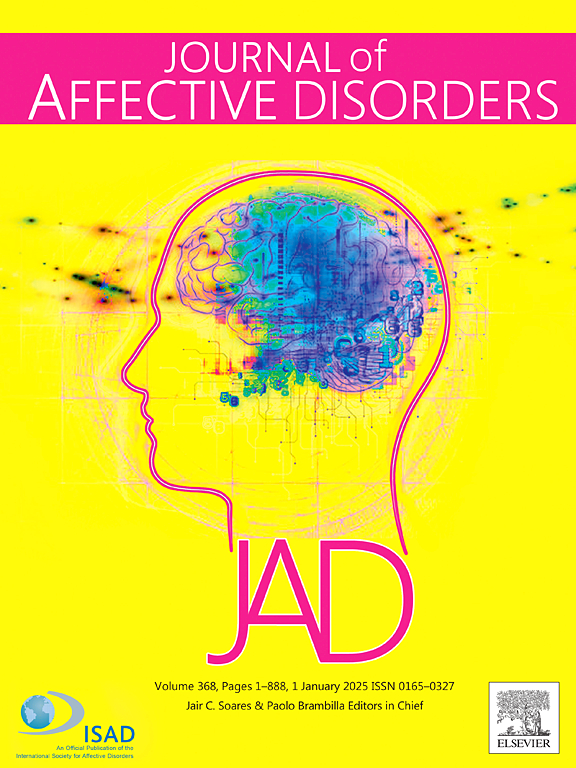部署的荷兰军事人员的延迟发作抑郁症状:确定部署前不同的心理、生化和遗传特征
IF 4.9
2区 医学
Q1 CLINICAL NEUROLOGY
引用次数: 0
摘要
背景抑郁症在军队中很常见,研究强调了部署后抑郁症状发展的差异性。本报告在以往研究成果的基础上,探讨了不同抑郁症状轨迹在部署前心理、生化和遗传变量方面的差异,尤其关注了延迟发病-增加的轨迹。方法 将部署到阿富汗(2005-2008 年)的 846 名军人样本分为复原型(66%,n = 558)、中度稳定型(20%,n = 173)、症状慢性型(9%,n = 74)和延迟发病-加重型(5%,n = 41),从部署前到部署后 10 年的轨迹进行分类。采用非参数多变量分析法研究了不同抑郁轨迹之间在部署前特征(如心理、生化和遗传)方面的差异。延迟发生-增加轨迹和中间稳定轨迹之间没有发现差异。与其他轨迹相比,症状-慢性轨迹和弹性轨迹在大多数部署前心理特征方面的得分都有显著差异。结论我们的研究发现,部署前的特征并不能区分延迟发病-增加型轨迹和中间稳定型轨迹,部署后出现的差异可能是由于负面生活事件造成的。在心理健康某一方面易受伤害的人可能会在多个心理领域面临风险,这突出表明有必要关注更广泛的症状,以支持易受伤害的军人并增强他们的复原力。本文章由计算机程序翻译,如有差异,请以英文原文为准。
Delayed onset of depressive symptoms in deployed Dutch military personnel: Identifying distinct psychological, biochemical, and genetic pre-deployment profiles
Background
Depression is common in the military, with research highlighting variability in depressive symptom development after deployment. This report builds on previous findings to explore differences in pre-deployment psychological, biochemical, and genetic variables across distinct depressive symptom trajectories, with a particular focus on the delayed-onset-increasing trajectory.
Methods
A sample of 846 military personnel deployed to Afghanistan (2005–2008) was categorized into resilient (66 %, n = 558), intermediate-stable (20 %, n = 173), symptomatic-chronic (9 %, n = 74), and delayed-onset-increasing (5 %, n = 41) trajectories from pre- to 10 years post-deployment. Differences in pre-deployment characteristics (e.g., psychological, biochemical, and genetic) among the depression trajectories were examined using a non-parametric multivariate analysis.
Results
Individuals in the delayed-onset-increasing trajectory had higher general mental health symptom scores than those in the resilient trajectory, but lower scores on fatigue, burnout, and personality factors than the symptomatic-chronic trajectory. No differences were found between the delayed-onset-increasing and the intermediate-stable trajectory. The symptomatic-chronic and resilient trajectories showed significant different scores across most pre-deployment psychological characteristics compared to the other trajectories. For the biochemical and genetic variables no significant differences were found.
Conclusions
Our study found that pre-deployment characteristics do not distinguish the delayed-onset-increasing trajectory from the intermediate-stable trajectory, with differences emerging post-deployment likely due to negative life events. Individuals vulnerable in one aspect of mental health may be at risk across multiple psychological domains, highlighting the need to focus on a broader range of symptoms to support vulnerable military personnel and enhance resilience.
求助全文
通过发布文献求助,成功后即可免费获取论文全文。
去求助
来源期刊

Journal of affective disorders
医学-精神病学
CiteScore
10.90
自引率
6.10%
发文量
1319
审稿时长
9.3 weeks
期刊介绍:
The Journal of Affective Disorders publishes papers concerned with affective disorders in the widest sense: depression, mania, mood spectrum, emotions and personality, anxiety and stress. It is interdisciplinary and aims to bring together different approaches for a diverse readership. Top quality papers will be accepted dealing with any aspect of affective disorders, including neuroimaging, cognitive neurosciences, genetics, molecular biology, experimental and clinical neurosciences, pharmacology, neuroimmunoendocrinology, intervention and treatment trials.
 求助内容:
求助内容: 应助结果提醒方式:
应助结果提醒方式:


